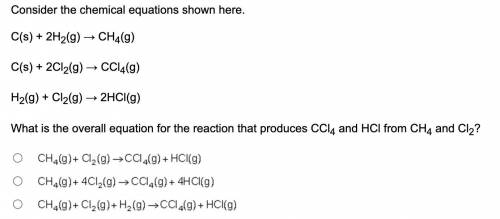
Chemistry, 18.03.2021 01:30 tristantisdale1
Consider the chemical equations shown here. C(s) + 2H2(g) → CH4(g) C(s) + 2Cl2(g) → CCl4(g) H2(g) + Cl2(g) → 2HCl(g) What is the overall equation for the reaction that produces CCl4 and HCl from CH4 and Cl2? Upper C upper H subscript 4 (g) plus upper C l subscript 2 (g) right arrow upper C upper C l subscript 4 (g) plus upper H upper C l (g). Upper C upper H subscript 4 (g) plus 4 upper C l subscript 2 (g) right arrow upper C upper C l subscript 4 (g) plus 4 upper H upper C l (g). Upper C upper H subscript 4 (g) plus upper C l subscript 2 (g) plus upper H 2 (g) right arrow upper C upper C l subscript 4 (g) plus upper H upper C l (g).


Answers: 3
Another question on Chemistry

Chemistry, 23.06.2019 04:31
One student said that the investigation was not valid (a fair test). write a plan for the investigation that includes improvements to the method and apparatus
Answers: 1

Chemistry, 23.06.2019 12:00
Which of the following involves only abiotic factors? a. a large rock being weathered by wind and rain b. an otter using a stone to break open a sea urchin c. a spider building a web in the corner of a building d. a pine tree absorbing light from the sun
Answers: 1

Chemistry, 23.06.2019 12:30
Growing crops in places where major pests don't live using beneficial insects to eat harmful insects using a rat trap instead of a rodenticide developing drought-resistant tomato plants using beneficial insects or natural oils to repel pests planting a different crop every year to fake out the pests keeping food covered to deter ants and rodents developing bean plants with a resistance to fungus picking caterpillars off tomato plants cultivation practice biological control cultural control genetic resistance natural chemicals
Answers: 3

Chemistry, 23.06.2019 18:10
A1 forms when an acid is neutralized by a base. 1. salts can be neutral, or in solutions. salts of 2. strong acid–strong base reactions produce solutions with 3. water. salts formed from the neutralization of weak acids or weak 4. bases water. they produce solutions that are acidic or . basic. for example, the ph of a solution at the equivalence point is . greater than for a acid titration. solutions that resist changes in ph are called solutions. the buffer is the amount of acid or base that can be added to a buffer without changing the ph greatly.
Answers: 1
You know the right answer?
Consider the chemical equations shown here. C(s) + 2H2(g) → CH4(g) C(s) + 2Cl2(g) → CCl4(g) H2(g) +...
Questions









History, 22.01.2020 22:31










Mathematics, 22.01.2020 22:31



